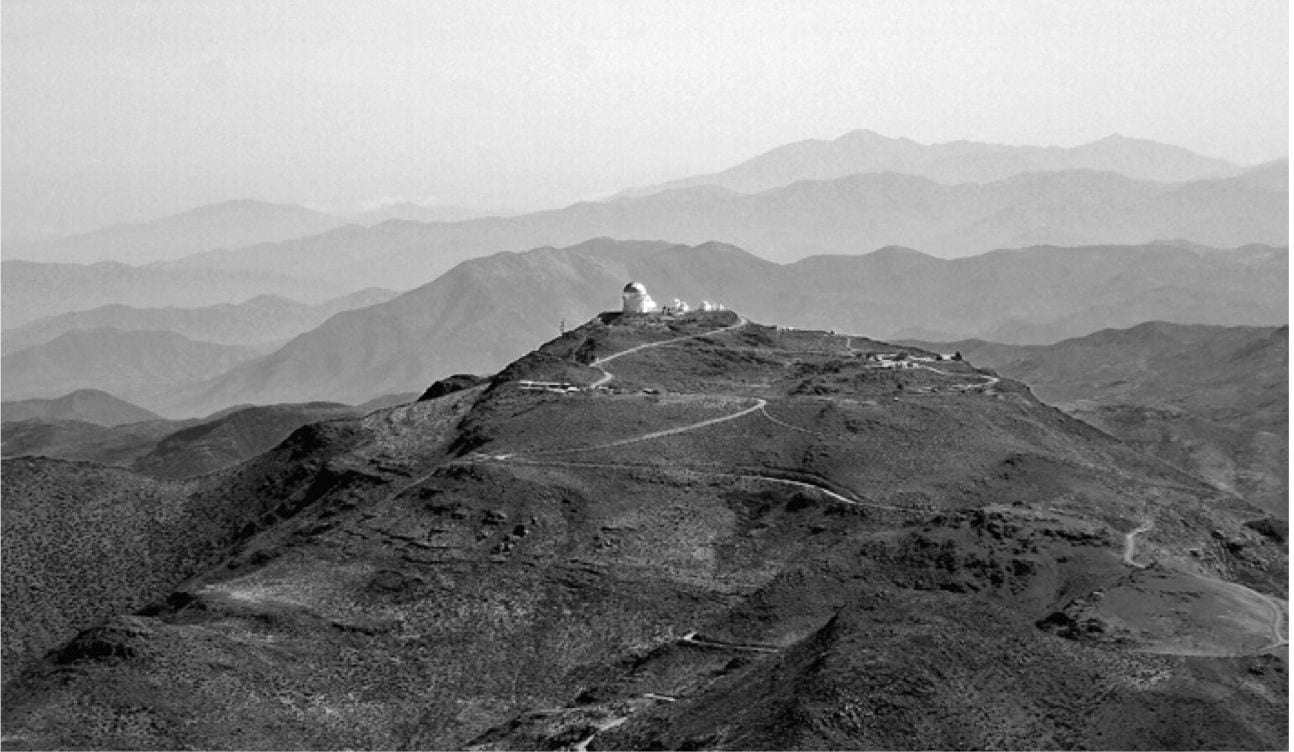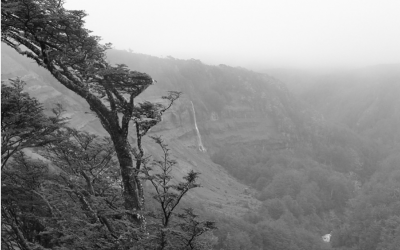Heaven Above
Peeking at the “Energetic Universe”

Cerro Tololo inter-american observatory as seen from cerro pachón, april 2004. Photo by D. Isabell and NOAO/AURA/NSF
Lasers, silicon-based light detectors, supercomputers, and giant glass disks all contribute to new techniques for astronomers to discover the properties of our universe. But one of the most powerful tools of modern astronomy is jet travel: it makes a telescope in Chile practical for observers from the north. And that’s important because Chile is the best place to observe.
It’s been the site of fascinating investigation into so-called dark energy and black holes that lurk in the centers of galaxies. A brand-new radio telescope and a new and larger optical telescope will soon make Chile’s modern observatory even more up-to-date.
The University of Chile actually created the initiative for modern observatories. In 1960, Prof. Frederico Rutlant suggested establishing a “cooperative” observatory and astronomers in the United States responded. Site surveys for optical telescopes, mostly staffed by people from the University of Chile, soon concentrated on the mountains on the southern fringe of the Atacama desert, in the north of Chile, not too far from the provincial capital of La Serena. By 1963, the Cerro Tololo Inter-American Observatory was a reality. The Carnegie Institution installed its first telescope at the Las Campanas Observatory in 1971, and the European Southern Observatory at La Silla started observations in 1964. These sites proved effective, with 300 clear star-lit nights a year and excellent atmospheric conditions that allow telescopes to form sharp, still images. This is what astronomers call, in our own argot, “good seeing.” Chile has the best seeing.
In the early days, the airline of choice (because there was no other choice) was Braniff, with airplanes painted goofy colors. Flights from Miami were infrequent and indirect, often including midnight stops in Guyaquil or Lima, or both. An astronomer arriving in Santiago could breathe the sweet scent of summer in Chile during a North American winter, but the trip was only halfway done. The next day was occupied by a long bus ride 250 miles up the Pan-American high-way. Vendors would hop on to offer toothache-inducing sweets as the bus labored up the hills near La Ligua. There was a brief lunch stop at the seaside town of Los Vilos, and then, just when your hopes of seeing La Serena were lifted by the distances posted on the road signs, the bus would veer off to Ovalle to let a few people off and on in that market town. From La Serena, the observatories ran their own vehicles either up the Elqui river valley to CTIO, or further north on the Pan American to Las Campanas. ESO ran its own flights to an airstrip at the base of La Silla, evoking envy (disguised as scorn). It was a long trip, but it was worth it.
Today, travel is easier, and the telescopes at the destinations are much more powerful. While I strongly recommend a walk outside on arrival to sniff summer through freshly thawed nostrils, you can walk from international arrivals over to national departures without going outside. The world of astronomy is a small town—there are about 10,000 astronomers. They are spread rather thinly around the globe, but the chances are good that the departure lounge for La Serena includes members of our tribe. Pallor, down jackets and laptops are distinguishing characteristics we use to recognize one another.
At Harvard, we’re partners in the Magellan Observatory, two telescopes at Las Campanas with 6.5 meter primary mirrors that were put into operation in 2000 and 2002. The drive from La Serena to Las Campanas is about two hours, ending with a climb up our own unpaved road to the mountain that ascends to almost 8000 feet. While our purpose is astronomy, and looking up, there’s no harm in looking horizontally. Chile is a skinny country––from the observatory you can see fog on the Pacific coastline off to the west, and the high ridge of the Cordillera and the border with Argentina off to the east.
The Magellan Telescopes were very carefully designed by our Carnegie partners to avoid disturbing the good seeing the site provides. They are kept cool, since temperature differences between the telescope and the nighttime air spoil the images. For the same reason, the enclosures can be opened up to let breezes flow through. This ventilation is good, but has to be balanced against the shaking that high winds can produce, which is not good. The building has a set of big adjustable louvers to regulate that flow of air. At the Magellan Telescopes, about once a minute, we analyze the images that the telescope is forming, compute the errors in the shape of the big 6.5 m mirror, and gently apply small forces to make it nearly the perfect shape. The combination of excellent atmospheric conditions, thoughtful engineering, and constant correction provides astronomers using the Magellan telescopes with the best natural seeing in the world.
In 1998, there was an amazing discovery published by an international team of astronomers that included many of my former students and postdocs and a strong representation from Chile that included Alejandro Clocciatti at the Pontificia Universidad Católica and Mark Phillips, Bob Schommer, Chris Smith, and Nick Suntzeff at Cerro Tololo. We showed that the expansion of the universe was speeding up. Astronomers had known from the 1920s that the universe was expanding, with the distances between galaxies stretching out over cosmic time. Most people who worked on cosmology expected that, once the measurements were good enough, we would find that the expansion was slowing down due to gravity. Our observations of distant supernovae, or exploding stars, showed that these expectations were wrong. Instead of gravity slowly braking the expansion something else, which we call the dark energy, appears to be speeding it up. In 1999, another group published the same result—if we were wrong, we had company.
Subsequent observations of more supernovae, of the glow from the Big Bang itself, and of the way galaxies are clumped together all point to a universe that is about 2/3 dark energy and only 1/3 matter. We have to take this seriously. I’ve changed the name of the course I teach for non-scientists from “Matter in the Universe” to “The Energetic Universe.” The dark energy seems real—but what is it?
One idea for the dark energy is that it is a modern version of Einstein’s “cosmological constant” a repulsive mathematical construction he invented to balance out gravity and make a static universe back in 1917. After Edwin Hubble demonstrated that the universe was expanding, Einstein tossed the cosmological constant into the history of science ashcan. But perhaps we need to dive back into Einstein’s dumpster to extract the cosmological constant as the source of the dark energy.
There are other possibilities: to distinguish between the cosmological constant and these alternatives; we need many more careful distance measurements to supernovae that exploded 5 billion years ago. To find and follow up these explosions, for 6 years, Professor Chris Stubbs and a large posse of astronomers from around the world have conducted the ESSENCE project. We’ve used the new generations of telescopes in Chile: the 4m telescope at Cerro Tololo and its 8 m neighbor of the Gemini Observatory, the twin 6.5 m telescopes at Magellan, and ESO’s wonderful new “Very Large Telescope,” with four 8m telescopes farther north, at Paranal, near Antofagasta. So far, our best efforts show that the mysterious substance that drives cosmic acceleration has exactly the same properties as the cosmological constant. Astonishing as it may be to have dark energy as the principal component of the universe, it would be even more interesting if we found that the dark energy was something more complicated than Einstein’s old idea.
Chile has as good a claim as any place to be the center of the astronomical universe. Future developments in the field recognize the unique aspects of Chile’s geography. The world is collaborating to build a radio telescope, the Atacama Large Millimeter Array, now taking shape 16,400 feet above sea level on the Chajnantor plain near San Pedro de Atacama. Many celestial objects that are invisible with optical light emit radio waves. Learning about the universe in this way will teach us about the origins of galaxies, of stars, and of planets. But ordinary water vapor can absorb these waves. The millimeter region of the radio spectrum is accessible only from sites that have extraordinarily dry air above them. San Pedro is legendary as a dry place and the Chajnator plain is so high that there is relatively little air above the antennas, providing a transparent view for this unique instrument.
Looking ahead, the partners of the Magellan Observatory, along with new partners, are now developing the plan for a new and larger optical telescope for the Las Campanas site. The first of seven giant 8.4 meter mirrors has already been cast for the Giant Magellan Telescope, which will take advantage of the steady air, dark skies, and dry clear nights that have already made Las Campanas a favorite destination for astronomers. This telescope will explore planets around other stars, black holes that lurk in the centers of galaxies, galaxies back through cosmic time, and may help us understand the dark energy that drives cosmic expansion. Looking up through the clear air of Chile is the best way to see where we have come from and to puzzle out what the world is made of. Astronomers are going to be traveling to Chile for a long time to come.
Spring 2009, Volume VIII, Number 3
Robert P. Kirshner is the Clowes Professor of Science at Harvard University.
Related Articles
Editor’s Letter: The Sky Above, The Earth Below
When I first started working on this ReVista issue on Colombia, I thought of dedicating it to the memory of someone who had died. Murdered newspaper editor Guillermo Cano had been my entrée into Colombia when I won an Inter American Press Association fellowship in 1977. Others—journalist Penny Lernoux and photographer Richard Cross—had also committed much of their lives to Colombia, although their untimely deaths were …
Other Cities, Other Worlds
Author of a marvelous book that excavates the palimpsests of memories encrypted in the image-filled voids of Berlin, Andreas Huyssen extends his investigation of the urban imaginary in…
Dirty Secrets, Dirty War: The Exile of Editor Robert J. Cox
t may be argued that Dirty Secrets, Dirty War: The Exile of Editor Robert J. Cox should have been written three decades ago, most likely in 1981, when Cox was enjoying, as I do now, a Nieman fellowship…




